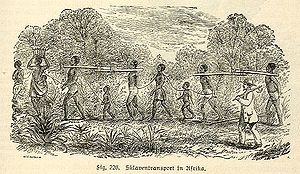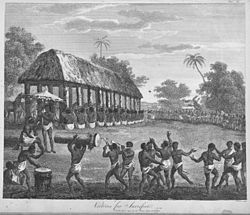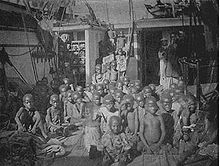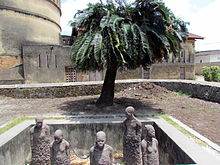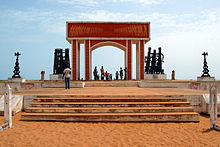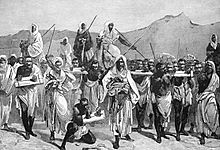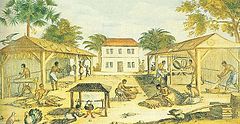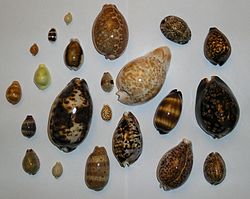
African slave trade
About this schools Wikipedia selection
SOS Children, which runs nearly 200 sos schools in the developing world, organised this selection. Sponsor a child to make a real difference.
| Slavery |
|---|
| Contemporary |
|
| Types |
|
| Historic |
|
| By country or region |
|
| Religion |
|
| Opposition and resistance |
|
| Related topics |
|
The African slave trade refers to the historic slave trade within Africa. Slavery in Africa has existed throughout the continent for many centuries to the current day. Systems of servitude and slavery were common in many parts of the continent, as they were in much of the ancient world. In most African societies, the enslaved people were also indentured servants and fully integrated, but not as Chattel slaves. When the Arab slave trade and Atlantic slave trade began, many local slave systems changed and began supplying captives for slave markets outside of Africa.
Slavery in historical Africa was practiced in many different forms and some of these do not clearly fit the definitions of slavery elsewhere in the world. Debt slavery (in Africa known as pawnship), enslavement of war captives, military slavery, slavery for sacrifice, and concubinage were all practiced in various parts of Africa.
Slavery was a small part of the economic life of many societies in Africa until the introduction of transcontinental slave trades (Arab and Atlantic). Although there had been some trans-Saharan trade from the interior of Sub-Saharan Africa to North Africa, the Horn of Africa, Middle East, and Europe.
Slave practices were again transformed with European colonization of Africa and the formal abolition of slavery in the early 1900s.
Forms of slavery
Multiple forms of slavery and servitude have existed throughout Africa during history and were shaped by indigenous practices of slavery as well as the Roman institution of slavery, the Islamic institutions of slavery, and eventually by the Atlantic slave trade. Slavery existed in all regions of Africa (like the rest of the world) and was a part of the economic structure of many societies for many centuries, although the extent varied. In sub-Saharan Africa, the slave relationships were oftentimes complex with rights and freedoms given to individuals held in slavery and restrictions on sale and treatment by their masters. Many communities had hierarchies between different types of slaves: for example, differentiating between those who had been born into slavery and those who had been capture through war. In many African societies, there was very little difference between the free peasants and the feudal vassal peasants. Enslaved people of the Songhay Empire were used primarily in agriculture; they paid tribute to their masters in crop and service but they were slightly restricted in custom and convenience. These non-free people were more an occupational caste, as their bondage was relative.
Scottish explorer Mungo Park wrote:
The slaves in Africa, I suppose, are nearly in the proportion of three to one to the freemen. They claim no reward for their services except food and clothing, and are treated with kindness or severity, according to the good or bad disposition of their masters. Custom, however, has established certain rules with regard to the treatment of slaves, which it is thought dishonourable to violate. Thus the domestic slaves, or such as are born in a man’s own house, are treated with more lenity than those which are purchased with money. ... But these restrictions on the power of the master extend not to the care of prisoners taken in war, nor to that of slaves purchased with money. All these unfortunate beings are considered as strangers and foreigners, who have no right to the protection of the law, and may be treated with severity, or sold to a stranger, according to the pleasure of their owners.—Mungo Park, Travels in the Interior of Africa
Slavery in African cultures was generally more like indentured servitude, although in certain parts of sub-Saharan Africa, slaves were used for human sacrifices in annual rituals, such as those rituals practiced by the denizens of Dahomey. Slaves were often not the chattel of other men, nor enslaved for life. Unfortunately this rarely extended to the slave traders and transporters, who preferred to weed out the "worthless, weak "individuals.
In regards to the indigenous slave trade, Dr. Akurang-Parry has said that:
The viewpoint that “Africans” enslaved “Africans” is obfuscating if not troubling. The deployment of “African” in African history tends to coalesce into obscurantist constructions of identities that allow scholars, for instance, to subtly call into question the humanity of “all” Africans. Whenever Asante rulers sold non-Asantes into slavery, they did not construct it in terms of Africans selling fellow Africans. They saw the victims for what they were, for instance, as Akuapems, without categorizing them as fellow Africans. Equally, when Christian Scandinavians and Russians sold war captives to the Islamic people of the Abbasid Empire, they didn’t think that they were placing fellow Europeans into slavery. This lazy categorizing homogenizes Africans and has become a part of the methodology of African history; not surprisingly, the Western media’s cottage industry on Africa has tapped into it to frame Africans in inchoate generalities allowing the media to describe local crisis in one African state as “African” problem.—Dr. Akurang-Parry, Ending the Slavery Blame
The forms of slavery in Africa were closely related to kinship structures. In many African communities, where land could not be owned, enslavement of individuals was used as a means to increase the influence a person had and expand connections. This made slaves a permanent part of a master's lineage and the children of slaves could become closely connected with the larger family ties. Children of slaves born into families could be integrated into the master's kinship group and rise to prominent positions within society, even to the level of chief in some instances. However, stigma often remained attached and there could be strict separations between slave members of a kinship group and those related to the master.
Chattel Slavery
Chattel slavery is a servitude relationship where the slave is treated as the property of the owner. As such, the owner is free to sell, trade, or treat the slave as they would other pieces of property and the children of the slave often are retained as the property of the master. Chattel slavery was practiced in the Nile river valley and Northern Africa but there is little evidence of widespread chattel slavery being practiced in sub-Saharan Africa prior to the expansion of Islamic legal systems which permitted this form of slavery as a means of conversion.
Domestic service
Many slave relationships in Africa revolved around domestic slavery, where slaves would work primarily in the house of the master but retain some freedoms. Domestic slaves could be considered part of the master's household and would not be sold to others without extreme cause. The slaves could own the profits from their labor (whether in land or in products) and could marry and pass the land on to their children in many cases.
Pawnship
Pawnship, or debt bondage slavery, involves the use of people as collateral to secure the repayment of debt. Slave labor is performed by the debtor, or a relative of the debtor (usually a child). Pawnship was a common form of collateral in West Africa, which involved the pledge of a person (or a member of the person's family) to service to a person providing credit. Pawnship was related to, yet distinct from slavery in most conceptualizations because the arrangement could include limited, specific terms of services to be provided and because kinship ties would protect the person from being sold into slavery. Pawnship was a common practice prior to European contact throughout West Africa, including amongst the Akan people, the Ewe people, the Ga people, the Yoruba people, and the Edo people (in modified forms, it also existed amongst the Efik people, the Igbo people, the Ijaw people, and the Fon people).
Military slavery
Military slavery involved the acquisition and training of conscripted military units which would retain the identity of military slaves even after their service. Slave soldier groups would be run by a Patron, who could be the head of a government or an independent warlord, and who would send his troops out for money and his own political interests.
This was most significant in the Nile valley (primarily in Sudan and Uganda), with slave military units organized by various Islamic authorities, and with the war chiefs of Western Africa. The military units in Sudan were formed in the 1800s through large-scale military raiding in the area which is currently the countries of Sudan and South Sudan.
Slaves for sacrifice
Although archeological evidence is not clear on the issue prior to European contact, in those societies which practiced human sacrifice, slaves became the most prominent victims.
Local slave trade
Several nations such as the Ashanti of present-day Ghana and the Yoruba of present-day Nigeria were involved in slave-trading. Groups such as the Imbangala of Angola and the Nyamwezi of Tanzania would serve as intermediaries or roving bands, waging war on African states to capture people for export as slaves. Historians John Thornton and Linda Heywood of Boston University estimate that 90 percent of those shipped to the New World were enslaved by Africans and then sold to European traders. Henry Louis Gates, the Harvard Chair of African and African American Studies, has stated that "without complex business partnerships between African elites and European traders and commercial agents, the slave trade to the New World would have been impossible, at least on the scale it occurred."
Slavery practices throughout Africa
Like most other regions of the world, slavery and forced labor existed in many kingdoms and societies of Africa for thousands of years. Precise evidence on slavery or the political and economic institutions of slavery before contact with the Arab or Atlantic slave trade is not available. The complex relationships and evidence from oral histories often incorrectly describe many forms of servitude or social status as slavery, even when the practices do not follow conceptualizations of slavery in other regions around the world.
The best evidence of slave practices in Africa come from the major kingdoms, particularly along the coast, and there is little evidence of widespread slavery practices in stateless societies. Slave trading was mostly secondary to other trade relationships; however, there is evidence of a trans-Saharan slave trade route from Roman times which persisted in the area after the fall of the Roman empire. However, kinship structures and rights provided to slaves (except those captured in war) appears to have limited the scope of slave trading before the start of the Arab slave trade and the Atlantic slave trade.
Northern Africa
Chattel slavery had been legal and widespread throughout North Africa when the region was controlled by the Roman Empire (47 BC - ca. 500 AD). The Sahel region south of the Sahara provided many of the African slaves held in North Africa during this period and there was a trans-Saharan slave trade in operation. Chattel slavery persisted after the fall of the Roman empire in the largely Christian communities of the region. After the Islamic expansion into most of the region, the practices continued and eventually, the chattel form of slavery spread to major societies on the southern end of the Sahara (such as Mali, Songhai, and Ghana).
The medieval slave trade in Europe was mainly to the East and South: the Byzantine Empire and the Muslim World were the destinations, Central and Eastern Europe an important source of slaves. Slavery in medieval Europe was so widespread that the Roman Catholic Church repeatedly prohibited it—or at least the export of Christian slaves to non-Christian lands was prohibited at, for example, the Council of Koblenz in 922, the Council of London in 1102, and the Council of Armagh in 1171. Because of religious constraints, the slave trade was monopolised in parts of Europe by Iberian Jews (known as Radhanites) who were able to transfer slaves from pagan Central Europe through Christian Western Europe to Muslim countries in Al-Andalus and Africa. So many Slavs were enslaved for so many centuries that word 'Slav' became synonymous with slavery. The derivation of the word slave encapsulates a bit of European history and explains why the two words (slaves and Slavs) are so similar; they are, in fact, historically identical.

The Mamluks were slave soldiers who converted to Islam and served the Muslim caliphs and the Ayyubid sultans during the Middle Ages. The first mamluks served the Abbasid caliphs in 9th century Baghdad. Over time they became a powerful military caste, and on more than one occasion they seized power for themselves, for example, ruling Egypt from 1250–1517. From 1250 Egypt had been ruled by the Bahri dynasty of Kipchak Turk origin. White enslaved people from the Caucasus served in the army and formed an elite corps of troops eventually revolting in Egypt to form the Burgi dynasty.
According to Robert Davis between 1 million and 1.25 million Europeans were captured by Barbary pirates and sold as slaves to North Africa and the Ottoman Empire between the 16th and 19th centuries. The coastal villages and towns of Italy, Portugal, Spain and Mediterranean islands were frequently attacked by the pirates and long stretches of the Italian and Spanish coasts were almost completely abandoned by their inhabitants; after 1600 Barbary pirates occasionally entered the Atlantic and struck as far north as Iceland. The most famous corsairs were the Ottoman Barbarossa ("Redbeard"), and his older brother Oruç, Turgut Reis (known as Dragut in the West), Kurtoğlu (known as Curtogoli in the West), Kemal Reis, Salih Reis and Koca Murat Reis.
In 1544, Hayreddin Barbarossa captured Ischia, taking 4,000 prisoners in the process, and deported to slavery some 9,000 inhabitants of Lipari, almost the entire population. In 1551, Dragut enslaved the entire population of the Maltese island Gozo, between 5,000 and 6,000, sending them to Libya. When pirates sacked Vieste in southern Italy in 1554 they took an estimated 7,000 slaves. In 1555, Turgut Reis sailed to Corsica and ransacked Bastia, taking 6000 prisoners. In 1558 Barbary corsairs captured the town of Ciutadella, destroyed it, slaughtered the inhabitants and carried off 3,000 survivors to Istanbul as slaves. In 1563 Turgut Reis landed at the shores of the province of Granada, Spain, and captured the coastal settlements in the area like Almuñécar, along with 4,000 prisoners. Barbary pirates frequently attacked the Balearic islands, resulting in many coastal watchtowers and fortified churches being erected. The threat was so severe that Formentera became uninhabited.
Sahrawi-Moorish society in Northwest Africa was traditionally (and still is, to some extent) stratified into several tribal castes, with the Hassane warrior tribes ruling and extracting tribute – horma – from the subservient Berber-descended znaga tribes.
Horn of Africa

In the Horn of Africa, the Solomonic dynasty of the Ethiopian Highlands often exported Nilotic slaves from their western borderland provinces, or from newly conquered or reconquered lowland territories. The Somali and Afar Muslim sultanates, such as the medieval Adal Sultanate, through their ports also traded Zanj (Bantu) slaves that were captured from the hinterland.
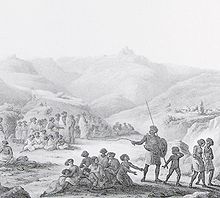
Slavery as practised in what is modern Ethiopia and Eritrea was essentially domestic. Slaves thus served in the houses of their masters or mistresses, and were not employed to any significant extent for productive purpose. Slaves were thus regarded as second-class members of their owners' family, and were fed, clothed and protected. They generally roamed around freely and conducted business as free people. They had complete freedom of religion and culture. The first attempt to abolish slavery in Ethiopia was made by Emperor Tewodros II (r. 1855–1868), although the slave trade was not abolished completely until 1923 with Ethiopia's ascension to the League of Nations. Anti-Slavery Society estimated there were 2 million slaves in the early 1930s out of an estimated population of between 8 and 16 million. Slavery continued in Ethiopia until the Italian invasion in October 1935, when the institution was abolished by order of the Italian occupying forces. In response to pressure by Western Allies of World War II, Ethiopia officially abolished slavery and involuntary servitude after having regained its independence in 1942. On 26 August 1942, Haile Selassie issued a proclamation outlawing slavery.
Bantu adult and children slaves (referred to collectively as jareer by their Somali masters) were purchased in the slave market exclusively to do work on plantation grounds. They toiled under the control of and separately from their Somali patrons. In terms of legal considerations, Bantu slaves were devalued. Additionally, Somali social mores strongly discouraged, censured and looked down upon any kind of sexual contact with Bantu slaves. Freedom for these plantation slaves was also often acquired through escape.
Central Africa
Oral tradition recounts slavery existing in the Kingdom of Kongo from the time of its formation with Lukeni lua Nimi enslaving the Mwene Kabunga whom he conquered to establish the kingdom. Early Portuguese writings show that the Kingdom did have slavery before contact, but that they were primarily war captives from the Kingdom of Ndongo.
West Africa
Slavery was practiced in diverse ways in the different communities of West Africa prior to European trade. With the development of the trans-Saharan slave trade and the economies of gold in the Western Sahel, a number of the major states became organized around the slave trade, including the Ghana Empire, the Mali Empire, and Songhai Empire. However, other communities in West Africa largely resisted the slave trade. The Mossi Kingdoms tried to take over key sites in the trans-Saharan trade and, when these efforts failed, the Mossi became defenders against slave raiding by the powerful states of the Western Sahel. The Mossi would eventually entere the slave trade in the 1800s with the Atlantic slave trade being the main market. Similarly, Walter Rodney identified no slavery or significant domestic servitude in early European accounts on the Upper Guinea region and I.A. Akinjogbin contends that European accounts reveal that the slave trade was not a major activity along the coast controlled by the Yoruba people and Aja people before Europeans arrived. With the beginning of the Atlantic slave trade, demand for slavery in West Africa increased and a number of states became centered on the slave trade and domestic slavery increased dramatically.
In Senegambia, between 1300 and 1900, close to one-third of the population was enslaved. In early Islamic states of the western Sudan, including Ghana (750–1076), Mali (1235–1645), Segou (1712–1861), and Songhai (1275–1591), about a third of the population were enslaved. In Sierra Leone in the 19th century about half of the population consisted of enslaved people. In the 19th century at least half the population was enslaved among the Duala of the Cameroon and other peoples of the lower Niger, the Kongo, and the Kasanje kingdom and Chokwe of Angola. Among the Ashanti and Yoruba a third of the population consisted of enslaved people. The population of the Kanem (1600–1800) was about a third-enslaved. It was perhaps 40% in Bornu (1580–1890). Between 1750 and 1900 from one- to two-thirds of the entire population of the Fulani jihad states consisted of enslaved people. The population of the Sokoto caliphate formed by Hausas in the northern Nigeria and Cameroon was half-enslaved in the 19th century.
When British rule was first imposed on the Sokoto Caliphate and the surrounding areas in northern Nigeria at the turn of the 20th century, approximately 2 million to 2.5 million people there were enslaved. Slavery in northern Nigeria was finally outlawed in 1936.
African Great Lakes
With sea trade from the eastern African Great Lakes region to Persia, China, and India during the first millennium AD, slaves are mentioned as a commodity of secondary importance to gold and ivory. When mentioned, the slave trade appears to be of a small-scale and mostly involve slave raiding of women and children along the islands of Kilwa Kisiwani, Madagascar and Pemba. Historians Campbell and Alpers argue that there were a host of different categories of labor in East Africa and that the distinction between slave and free individuals was not particularly relevant in most societies. However, with increasing international trade in the 18th and 19th century, East Africa began to be involved significantly in the Atlantic slave trade; for example, with the king of Kilwa island signing a treaty with a French merchant in 1776 for the delivery of 1,000 slaves per year. At about the same time, merchants from Oman, India, and East Africa began establishing plantations along the coasts and on the islands. To provide workers on these plantations, slave raiding and slave holding became increasingly important in the region and slave traders (most notably Tippu Tip) became prominent in the political environment of the region. The East African trade reached its height in the early decades of the 1800s with up to 30,000 slaves sold per year. However, slavery never became a significant part of the domestic economies except in Sultanate of Zanzibar where plantations and agricultural slavery were maintained.
In the Great Lakes region of Africa (around present-day Uganda), linguistic evidence shows the existence of slavery through war capture, trade, and pawning going back hundreds of years; however, these forms, particularly pawning, appear to have increased significantly in the 18th and 19th centuries.
Transformations of slavery in Africa
Slave relationships in Africa have been transformed through three large scale processes: the Arab slave trade, the Atlantic slave trade, and the slave emancipation policies and movements in the 20th century. Each of these processes significantly changed the forms, level, and economics of slavery in Africa.
Slave practices in Africa were used during different periods to justify specific forms of European engagement with the peoples of Africa. Eighteenth century writers in Europe claimed that slavery in Africa was quite brutal in order to justify the Atlantic slave trade. Later writers used similar arguments to justify intervention and eventual colonization by European powers to end slavery in Africa.
Africans knew of the harsh slavery that awaited slaves in the New World. Many elite Africans visited Europe on slave ships following the prevailing winds through the New World. One example of this occurred when Antonio Manuel, Kongo’s ambassador to the Vatican, went to Europe in 1604, stopping first in Bahia, Brazil, where he arranged to free a countryman who had been wrongfully enslaved. African monarchs also sent their children along these same slave routes to be educated in Europe, and thousands of former slaves eventually returned to settle Liberia and Sierra Leone.
Trans-Saharan and Indian Ocean trade
The Arab slave trade, established in the 8th and 9th centuries AD involved a small-scale movement of people largely from East Africa and the Sahel. Islam allowed chattel slavery but prohibited this form of slavery if it involved other Muslims; as a result, the main target for slavery were the people who lived in the frontier areas of Islam in Africa. The trade of slaves across the Sahara and across the Indian Ocean also has a long history beginning with the control of sea routes by Afro-Arab traders in the ninth century. It is estimated that only a few thousand enslaved people were taken each year from the Red Sea and Indian Ocean coast. They were sold throughout the Middle East. This trade accelerated as superior ships led to more trade and greater demand for labour on plantations in the region. Eventually, tens of thousands per year were being taken. In east Africa the main slave trade involved arabised east Africans
This changed the slave relationships by creating new forms of employment by slaves (as eunuchs to guard harems and in military units) and creating conditions for freedom (namely conversion--although it would only free a slave's children). Although the level of the trade remained small, the size of total slaves traded grew to a large number of the multiple centuries of its existence. Because of its small and gradual nature, the impact on slavery practices in communities that did not convert to Islam was relatively small. However, in the 1800s, the slave trade from Africa to the Islamic countries picked up significantly. When the European slave trade ended around the 1850s, the slave trade to the east picked up significantly only to be ended with European colonization of Africa around 1900.
David Livingstone wrote of the slave trade: "To overdraw its evils is a simple impossibility ... We passed a slave woman shot or stabbed through the body and lying on the path. [Onlookers] said an Arab who passed early that morning had done it in anger at losing the price he had given for her, because she was unable to walk any longer. We passed a woman tied by the neck to a tree and dead ... We came upon a man dead from starvation ... The strangest disease I have seen in this country seems really to be broken heartedness, and it attacks free men who have been captured and made slaves." Livingstone estimated that 80,000 Africans died each year before ever reaching the slave markets of Zanzibar. Zanzibar was once East Africa's main slave-trading port, and under Omani Arabs in the 19th century as many as 50,000 slaves were passing through the city each year.
Atlantic slave trade
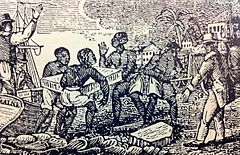
The Atlantic slave trade radically transformed slavery practices outside of the areas directly controlled by Muslim governments (who largely continued Islamic forms of slavery). The Atlantic slave trade was so significant that it transformed Africans from a small percentage of the global population of slaves in 1600 into the overwhelming majority by 1800. In non-Islamic parts of Africa, the slavery practices and institutions were changed dramatically. The slave trade was transformed from a marginal aspect of the economies into the largest sector in a relatively short span. In addition, agricultural plantations increased significantly and became a key aspect in many societies. Finally, it transformed the traditional distribution of the slave practices. African and Arab slave trades had large demand for women and children (who would be trained in various crafts), but the European slave traders demanded men increasing the practices of slave raiding and getting slaves through warfare.
The first Europeans to arrive on the coast of Guinea were the Portuguese; the first European to actually buy enslaved Africans in the region of Guinea was Antão Gonçalves, a Portuguese explorer in 1441 AD. Originally interested in trading mainly for gold and spices, they set up colonies on the uninhabited islands of São Tomé. In the 16th century the Portuguese settlers found that these volcanic islands were ideal for growing sugar. Sugar growing is a labour-intensive undertaking and Portuguese settlers were difficult to attract due to the heat, lack of infrastructure, and hard life. To cultivate the sugar the Portuguese turned to large numbers of enslaved Africans. Elmina Castle on the Gold Coast, originally built by African labour for the Portuguese in 1482 to control the gold trade, became an important depot for slaves that were to be transported to the New World.
The Spanish were the first Europeans to use enslaved Africans in the New World on islands such as Cuba and Hispaniola, where the alarming death rate in the native population had spurred the first royal laws protecting the native population (Laws of Burgos, 1512–1513). The first enslaved Africans arrived in Hispaniola in 1501 soon after the Papal Bull of 1493 gave all of the New World to Spain.
The Atlantic slave trade peaked in the late 18th century, when the largest number of slaves were captured on raiding expeditions into the interior of West Africa. The increase of demand for slaves due to the expansion of European colonial powers to the New World made the slave trade much more lucrative to the West African powers, leading to the establishment of a number of actual West African empires thriving on slave trade. These included Oyo empire ( Yoruba), Kong Empire, Kingdom of Benin, Imamate of Futa Jallon, Imamate of Futa Toro, Kingdom of Koya, Kingdom of Khasso, Kingdom of Kaabu, Fante Confederacy, Ashanti Confederacy, and the kingdom of Dahomey. The gradual abolition of slavery in European colonial empires during the 19th century again led to the decline and collapse of these African empires. These kingdoms that relied on a militaristic culture of constant warfare to generate the great numbers of human captives required for trade with the Europeans.
When European powers began to actively stop the Atlantic slave trade, this caused a further transformation in that large holders of slaves in Africa transitioned to putting the slaves to work on plantations and other agricultural products.
Abolition
|
|||||
The final major transformation of slave relationships came with the inconsistent emancipation policies and movements starting in the mid-1800s. Colonial policies were often confusing on the issues; for example, even when slavery was illegal, colonial authorities would return escaped slaves to their masters. Slavery persisted in many countries under colonial rule and in many parts it was not until independence that slavery practices were significantly transformed. Although independence struggles generally brought former slaves and former masters together to fight for independence, in the 1960s many organized politically based on these former stratifications. In some parts of Africa, slavery and slavery-like practices continue to this day and the problem has proven to be difficult for governments and civil society to eliminate.
Beginning in the late 18th century, France was one of Europe's first countries to abolish slavery, in 1794, but it was revived by Napoleon in 1802, and banned for good in 1848. Denmark-Norway was the first European country to ban the slave trade. This happened with a decree issued by the king in 1792, to become fully effective by 1803. Slavery itself was not banned until 1848. In 1807 the British Parliament passed the Abolition of the Slave Trade Act, under which captains of slave ships could be stiffly fined for each slave transported. This was later superseded by the 1833 Slavery Abolition Act, which freed all slaves in the British Empire. Abolition was then extended to the rest of Europe. The 1820 U.S. Law on Slave Trade made slave trading piracy, punishable by death. In 1827, Britain declared the slave trade to be piracy, punishable by death. The power of the Royal Navy was subsequently used to suppress the slave trade, and while some illegal trade, mostly with Brazil, continued, the Atlantic slave trade was eradicated in the year 1850 by senator Eusebio de Queiroz, Minister of Justice of the Empire of Brazil, the law was called Law Eusebio de Queiroz. After struggles that lasted for decades in the Empire of Brazil, slavery was abolished completely in 1888 by Princess Isabel of Brazil and Minister Rodrigo Silva (son-in-law of senator Eusebio de Queiroz). The West Africa Squadron was credited with capturing 1,600 slave ships between 1808 and 1860 and freeing 150,000 Africans who were aboard these ships. Action was also taken against African leaders who refused to agree to British treaties to outlaw the trade, for example against ‘the usurping King of Lagos’, deposed in 1851. Anti-slavery treaties were signed with over 50 African rulers.
The Islamic trans-Saharan and Indian Ocean trades continued, however, and even increased as new sources of enslaved people became available. In Caucasus, slavery was abolished after Russian conquest. The slave trade within Africa also increased. The British Navy could suppress much of the trade in the Indian Ocean, but the European powers could do little to affect the land-based intra-continental trade.
The continuing anti-slavery movement in Europe became an excuse and a casus belli for the European conquest and colonisation of much of the African continent. In the late 19th century, the Scramble for Africa saw the continent rapidly divided between Imperialistic European powers, and an early but secondary focus of all colonial regimes was the suppression of slavery and the slave trade. In response to this pressure, Ethiopia officially abolished slavery in 1932. By the end of the colonial period they were mostly successful in this aim, though slavery is still very active in Africa even though it has gradually moved to a wage economy. Independent nations attempting to westernise or impress Europe sometimes cultivated an image of slavery suppression, even as they, in the case of Egypt, hired European soldiers like Samuel White Baker's expedition up the Nile. Slavery has never been eradicated in Africa, and it commonly appears in African states, such as Chad, Ethiopia, Mali, Niger, and Sudan, in places where law and order have collapsed. See also Slavery in modern Africa.
Although outlawed in nearly all countries today, slavery is practised in secret in many parts of the world. There are an estimated 27 million victims of slavery worldwide. In Mauritania alone, up to 600,000 men, women and children, or 20% of the population, are enslaved, many of them used as bonded labour. Slavery in Mauritania was finally criminalised in August 2007. It is estimated that as many as 200,000 Sudanese children and women have been taken into slavery in Sudan during the Second Sudanese Civil War. In Niger, where the practice of slavery was outlawed in 2003, a study found that almost 8% of the population are still slaves. In many Western countries, slavery is still prevalent in the form of sexual slavery.
Effects
Demographics
The demographic effects of the slave trade are some of the most controversial and debated issues. Walter Rodney argued that the export of so many people had been a demographic disaster and had left Africa permanently disadvantaged when compared to other parts of the world, and that this largely explains that continent's continued poverty. He presents numbers that show that Africa's population stagnated during this period, while that of Europe and Asia grew dramatically. According to Rodney all other areas of the economy were disrupted by the slave trade as the top merchants abandoned traditional industries to pursue slaving and the lower levels of the population were disrupted by the slaving itself.
Others have challenged this view. J. D. Fage compared the number effect on the continent as a whole. David Eltis has compared the numbers to the rate of emigration from Europe during this period. In the nineteenth century alone over 50 million people left Europe for the Americas, a far higher rate than were ever taken from Africa.
Others have challenged this view. Joseph E. Inikori argues the history of the region shows that the effects were still quite deleterious. He argues that the African economic model of the period was very different from the European, and could not sustain such population losses. Population reductions in certain areas also led to widespread problems. Inikori also notes that after the suppression of the slave trade Africa's population almost immediately began to rapidly increase, even prior to the introduction of modern medicines. Shahadah also states that the trade was not only of demographic significance, in aggregate population losses but also in the profound changes to settlement patterns, epidemiological exposure and reproductive and social development potential. In addition, the majority of the slaves being taken to the Americas were male. So while the slave trade created an immediate drop in the population, its long term effects were even more drastic.
Effect on the economy of Africa
There is a longstanding debate amongst analysts and scholars about the destructive impacts of the slave trades. It is often claimed that the slave trade undermined local economies and political stability as villages' vital labour forces were shipped overseas as slave raids and civil wars became commonplace. With the rise of a large commercial slave trade, driven by European needs, enslaving your enemy became less a consequence of war, and more and more a reason to go to war. The slave trade, it is claimed, impeded the formation of larger ethnic groups, causing ethnic factionalism and weakening the formation for stable political structures in many places. It also is claimed to have reduced the mental health and social development of African people.
In contrast to these arguments, J.D. Fage asserts that slavery did not have a wholly disastrous effect on the societies of Africa. Slaves were an expensive commodity, and traders received a great deal in exchange for each enslaved person. At the peak of the slave trade hundreds of thousands of muskets, vast quantities of cloth, gunpowder, and metals were being shipped to Guinea. Most of this money was spent on British-made firearms (of very poor quality) and industrial-grade alcohol. Trade with Europe at the peak of the slave trade—which also included significant exports of gold and ivory—was some 3.5 million pounds Sterling per year. By contrast, the trade of the United Kingdom, the economic superpower of the time, was about 14 million pounds per year over this same period of the late 18th century. As Patrick Manning has pointed out, the vast majority of items traded for slaves were common rather than luxury goods. Textiles, iron ore, currency, and salt were some of the most important commodities imported as a result of the slave trade, and these goods were spread within the entire society raising the general standard of living.
Effects on Europe's economy
Karl Marx in his economic history of capitalism, Das Kapital, claimed that '...the turning of Africa into a warren for the commercial hunting of black-skins [that is, the slave trade], signalled the rosy dawn of the era of capitalist production.' He argued that the slave trade was part of what he termed the 'primitive accumulation' of European capital, the 'non-capitalist' accumulation of wealth that preceded and created the financial conditions for Britain's industrialisation.
Eric Williams has written about the contribution of Africans on the basis of profits from the slave trade and slavery, arguing that the employment of those profits were used to help finance Britain’s industrialisation. He argues that the enslavement of Africans was an essential element to the Industrial Revolution, and that European wealth was, in part, a result of slavery, but that by the time of its abolition it had lost its profitability and it was in Britain's economic interest to ban it. Joseph Inikori has written that the British slave trade was more profitable than the critics of Williams believe. Other researchers and historians have strongly contested what has come to be referred to as the “Williams thesis” in academia: David Richardson has concluded that the profits from the slave trade amounted to less than 1% of domestic investment in Britain, and economic historian Stanley Engerman finds that even without subtracting the associated costs of the slave trade (e.g., shipping costs, slave mortality, mortality of whites in Africa, defense costs) or reinvestment of profits back into the slave trade, the total profits from the slave trade and of West Indian plantations amounted to less than 5% of the British economy during any year of the Industrial Revolution. Historian Richard Pares, in an article written before Williams’ book, dismisses the influence of wealth generated from the West Indian plantations upon the financing of the Industrial Revolution, stating that whatever substantial flow of investment from West Indian profits into industry there was occurred after emancipation, not before.
Seymour Drescher and Robert Anstey argue the slave trade remained profitable until the end, because of innovations in agriculture, and that moralistic reform, not economic incentive, was primarily responsible for abolition.
A similar debate has taken place about other European nations. French slave trade, it is argued, was more profitable than alternative domestic investments and probably encouraged capital accumulation before the Industrial Revolution and Napoleonic Wars.
Legacy of racism
Maulana Karenga states that the effects of the Atlantic slave trade in African captives was "the morally monstrous destruction of human possibility involved redefining African humanity to the world, poisoning past, present and future relations with others who only know us through this stereotyping and thus damaging the truly human relations among people of today". He cites that it constituted the destruction of culture, language, religion and human possibility.

